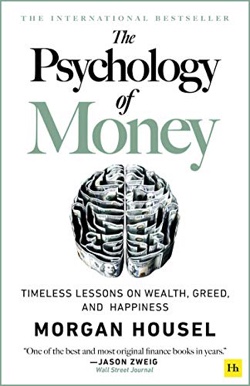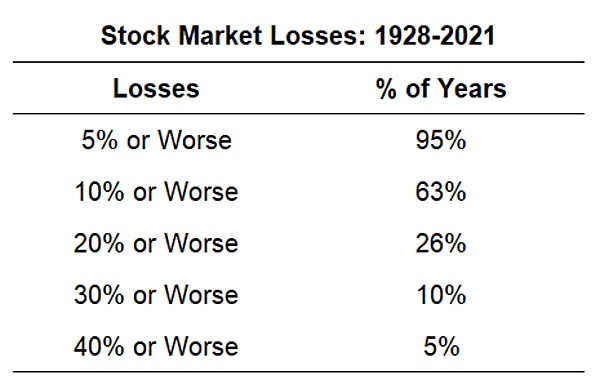 On March 6, 2009, the S&P 500 index hit 666.80, shedding 13 years of gains. 13 years! Guess how long it has been since March 2009? 13 years! Something to ponder as the possibility of more war looms ahead.
On March 6, 2009, the S&P 500 index hit 666.80, shedding 13 years of gains. 13 years! Guess how long it has been since March 2009? 13 years! Something to ponder as the possibility of more war looms ahead.
I remember my portfolio being halved at the time and thinking… how can it not eventually be back at at 1,000? Should I double down on stocks? Meanwhile, Goldman Sachs released “analyst research” that warned the S&P could fall as low as 400. People were panicked and “get out now and wait until things calm down” started to sound more and more like solid advice. The best I could do was not sell anything.
I am re-reading The Psychology of Money by Morgan Housel. In this book of timeless advice about controlling your behavior, he points out that the long-term stock returns that we all expect is not free. There is a price that must be paid.
Like everything else worthwhile, successful investing demands a price. But its currency is not dollars and cents. It’s volatility, fear, doubt, uncertainty, and regret—all of which are easy to overlook until you’re dealing with them in real time.
We should accept this price volatility as an expected cost of doing business, not something to be avoided:
It sounds trivial, but thinking of market volatility as a fee rather than a fine is an important part of developing the kind of mindset that lets you stick around long enough for investing gains to work in your favor. Few investors have the disposition to say, “I’m actually fine if I lose 20% of my money.” This is doubly true for new investors who have never experienced a 20% decline. But if you view volatility as a fee, things look different.
From A Wealth of Common Sense, we can get a better understanding of How Often Should You Expect a Stock Market Correction?

I would add one thing. Accepting price swings after looking at a chart may sound okay in isolation. However, you should also prepare for the fact that there will always be a great reason for those drops. We’ve had housing bubbles and dot-com bubbles and now worldwide pandemics. But the next reason will likely be different. And it will be a widely-accepted, legit, scary reason. I will be scared. You will be scared.
If I mentally agree to pay this price now, hopefully it will help me when the next scary thing inevitably comes along.
 The Best Credit Card Bonus Offers – 2025
The Best Credit Card Bonus Offers – 2025 Big List of Free Stocks from Brokerage Apps
Big List of Free Stocks from Brokerage Apps Best Interest Rates on Cash - 2025
Best Interest Rates on Cash - 2025 Free Credit Scores x 3 + Free Credit Monitoring
Free Credit Scores x 3 + Free Credit Monitoring Best No Fee 0% APR Balance Transfer Offers
Best No Fee 0% APR Balance Transfer Offers Little-Known Cellular Data Plans That Can Save Big Money
Little-Known Cellular Data Plans That Can Save Big Money How To Haggle Your Cable or Direct TV Bill
How To Haggle Your Cable or Direct TV Bill Big List of Free Consumer Data Reports (Credit, Rent, Work)
Big List of Free Consumer Data Reports (Credit, Rent, Work)
I remember reading Warren Buffet’s October 18, 2008 NY Times opinion piece “Buy American. I am” a few months before the March 2009 lows. It helped me have courage in the conviction to stay the course – with an allocation in stocks as planned for the relative long term.
Hi Jonathan, what’s your estimate of the probability that the S&P 500 sees 666 again some time in the next ten-to-fifteen years? over 1%? 0.1%-1%? Below 0.1%?
I’m not Jonathan, but IMHO over 90% by 2030 the stocks will tank erasing the last 10 yrs of gains, cannot predict the exact price level though.
I remain both a long-term optimist and also a scaredy-cat that keeps the equivalent of 10 years of expenses in bonds. (30% bond allocation divided by 3% withdrawal rate.) And that doesn’t even count the dividends that I earn from the stocks.
I want to be able to survive anything without being forced to sell a single business in my portfolio, just like Berkshire.
There is the real, nagging issue of “self-fulfilling prophecy.” Another commenter made reference to the Warren Buffett “Buy American” piece–I remember that piece, and the (unusual) derivative Buffett held at the time (a huge S&P 500 long position), and the palpable fear Buffett himself began to exude over the months from late 2008 to early 2009. Back to the “self-fulfilling prophecy” notion: as long as enough people with enough money continue to buy dips, things work out. Certainly that has been happening massively since the advent of Modern Portfolio Theory, and even more so post 2009. That does not make it axiomatic, however. The fact that people view “eventually, no matter what price you pay, given enough time you will profit” *as an axiom* is what scares me the most.